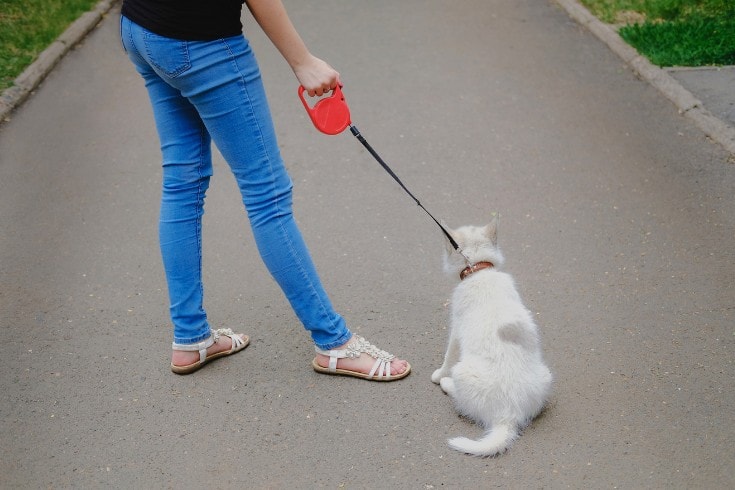Retractable leashes have seriously injured dogs and their owners, but this type of leash is still extremely popular with many pet parents.
But why are retractable leashes considered dangerous by many vets and trainers? What retractable leash injuries can occur? And can a retractable leash ever be a safe choice of a leash?
Keep reading to learn everything you need about retractable leash injuries and how to prevent them.
What Is a Retractable Leash?

So, what is a retractable dog leash, and how does it work?
This type of leash is essentially a thin length of cord that’s wound around a spring-loaded mechanism inside a large plastic handle. The handle is ergonomically designed to fit comfortably in your hand. You press a button on the handle to release the cord and rewind it.
The idea of the retractable leash is that the dog gets to enjoy limited wandering and exploring while still under your control rather than being restricted to walking beside you.
Retractable leashes come in different sizes but can extend up to 26 feet. Most of these leases don’t have a loop handle like a classic leash that you can wrap around your wrist for security. That means you’re holding a handle rather than the leash itself.
So, it’s much easier for you to drop the retractable leash if the dog charges to the end of the cord and tugs the leash from your hand.
Why Are Retractable Leashes Popular?
Retractable leashes are extremely popular with dog owners since they allow the dog more freedom to enjoy sniffing around while out on walks in places where off-leash walking is not safe or permitted.
If you have a well-mannered dog that’s reliable on his leash, a retractable leash could work for you.
I sometimes used a retractable leash for my senior dog. Jess had arthritis and was pretty slow, so I knew she wouldn’t pull or tug on her leash. The retractable leash meant that my elderly dog could enjoy lots of sniffing and controlled wandering in the park, which she loved.
Reasons NOT to Use a Retractable Leash

If you’re still considering using a retractable leash, here are some reasons why you should think twice about trading in your traditional leather leash.
- Retractable leashes can present a danger in busy environments since a dog can get far enough away from its handler to cause problems.
- Your dog might dash out into a busy street or come into contact with other dogs and strangers with unexpected consequences.
- If your dog is at the end of the leash cord 26 feet away from you and is approached by an aggressive dog, you’ll struggle to rescue your dog if a fight breaks out.
- It’s much easier to regain control of your dog in a tricky situation if he’s on a 6-foot leash than it is if he’s 26 feet away.
- A large, strong dog can easily snap a thin leash cord. Thicker, stronger retractable leash cords are not much safer since they can extend incredibly quickly, easily ripping the leash handle from your grasp.
- You or another dog walker can easily become tangled in a retractable leash cord, especially if two dogs are playing or scrapping.
- Your dog could be injured if he becomes tangled up in the leash cord.
- Some dogs are frightened by the sound of the leash extending or of the clattering noise the handle makes if you drop it. That can result in the dog taking off in alarm and running clear away.
- If your dog gets loose, he might think the leash handle is chasing him, and he can’t escape it! Even if your pet isn’t physically harmed in such an incident, he might be fearful of his leash in the future.
- Retractable leashes contain mechanical parts that can fail. In that case, the leash might not retract or extend or, even worse, could unspool randomly when you least expect it.
- By using a retractable leash, you can inadvertently train your dog to pull since the dog learns that pulling extends the leash and allows him more freedom.
Interestingly, many vet clinics do not permit the use of retractable leashes for safety reasons.
When Can You Use a Retractable Leash

You could use a retractable leash if you have a well-mannered dog that’s reliably leash-trained and will walk politely alongside you without pulling. In addition, your dog must reliably come back to you when called.
If a dog is partially sighted due to old age, a retractable leash can be a good way of allowing the pup some freedom to wander and enjoy a sniff around without getting lost.
Some dogs are “shy” when it comes to relieving themselves and refuse to do so on the leash. In many cases, a 12-foot leash allowance gives the dog the privacy and distance he wants to do his business while still remaining on the leash.
Retractable Leash Injuries to Handlers
Retractable leash injuries to pet parents are surprisingly common and can be very serious.
Injuries often happen when the leash breaks and becomes detached from the handle. The handler grabs the leash cord to regain control of their dog, often sustaining rope burns, cuts, or even losing a finger!
Amputation can also occur if a thin leash cord gets wrapped around a limb. If your dog takes off and pulls out 20 feet of leash or more, that cord produces a lot more friction than a 4- or 6-foot leash. The friction caused by that can cause severe injuries.
If you have a very powerful dog, you can be dragged right off your feet when the dog reaches the end of the cord and keeps on going. That’s because the dog’s momentum has built up, so you feel the full force of your pup when he reaches the end of the leash.
The injuries caused by that kind of accident can be serious, including broken bones, scrapes, bruises, grazes, cuts, and scrapes.
Retractable Leash Injuries to Dogs

Your dog is also at risk of serious bodily injury from an out-of-control retractable leash.
- When the dog dashes off and reaches the end of the leash, he’ll experience an abrupt tug on his neck. That can cause neck wounds, spinal cord injuries, or a lacerated trachea if the cord gets wrapped around the dog’s neck.
We recommend using a harness rather than a collar for walking your dog. That would prevent such injuries from occurring. - If a dog dashes out into the street, he could be hit by a passing vehicle.
- Your dog could be injured if he gets tangled up with bicycles or other dogs.
- If the dog becomes entangled in the leash cord, he could have his leg or tail severely lacerated or even amputated when the cord retracts.
- Retractable leash handles are bulky and quite heavy. If the dog manages to pull the handle out of the owner’s hand, he will be “chased” by the handle. That’s mentally terrifying for the dog and can result in physical injury if the handle strikes the dog.
Many times, owners have reported that their dogs became fearful of being walked thanks to an accident involving a retractable leash.
Traditional Leashes Are the Best Choice
In most cases, traditional leashes are a much safer leash choice for dogs and their owners.
A regular flat leash is a much easier tool to use when it comes to classic leash training. Loose leash walking skills are much easier to establish when using a six-foot standard flat leash than struggling to control a Flexi leash.
Although traditional leashes suffer from wear and tear over time, any damage is easy to spot, whereas damage to a retractable leash is hidden inside the handle and can easily go undetected until it’s too late.
Expert Opinion

Cesar Millan, the world-famous canine professional, is clear in his opinion of the use of retractable dog leashes.
Millan says that the retractable leash style has a specific purpose in that it was intended for use with recall training and some forms of tracking. The retractable leash is not suitable for loose leash walking training.
FAQs
Here are the answers to some of the most commonly asked questions regarding retractable leashes and their dangers.
Q: What is the problem with retractable leashes?
A: Retractable leashes can cause injuries to dogs, their handlers, and anyone nearby. The leash cord is very thin and can easily wrap around your fingers or legs, causing friction burns and other minor injuries. In severe cases, amputation of a finger can happen.
Dogs can become entangled in the leash cord and with that of another dog. If the dog’s neck or limbs become tangled in the leash cord, severe injuries can result.
Q: Why do dog trainers not like retractable leashes?
A: Retractable leashes teach dogs that they can gain more freedom by pulling on the leash so that it extends. That’s not helpful if you’re training your dog to walk on a loose leash.
Q: Are there any safe retractable leashes?
A: All retractable leashes work in the same way, so all present the same risks to owners and dogs. However, if you have a polite dog with good leash manners, a high-quality retractable leash can be safe if used correctly.
Q: Are retractable leashes good for strong dogs?
A: Generally, retractable leashes are not a good choice for powerful, strong dogs. In some cases, the leash cord can snap under the dog’s weight. The retractable leash handle can often be tugged from the owner’s hand when the dog dashes to the extent of the leash cord.
Final Thoughts
I hope you enjoyed our guide on retractable leash injuries. If you did, please share the article before you go!
Retractable leashes are not good types of leashes for leash pullers and can even encourage the habit. Using a retractable leash can result in major injuries for you and your dog. In addition, retractable leashes are more prone to failure than regular leashes since they have a locking mechanism inside the handle.
What type of dog leash do you use for your pup and why? Tell us in the comment box below!
